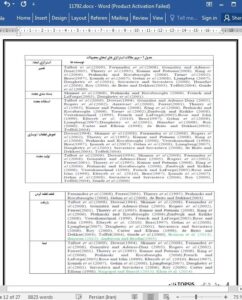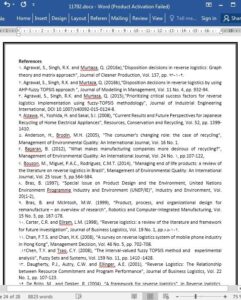Purpose - The article aims to explore the product disposition strategies in reverse supply chains and to develop a framework to prioritize these strategies for effective reverse supply chain implementation.
Design/Methodology/Approach –The disposition strategies, based on the literature review were selected, and fuzzy TOPSIS methodology has been applied for the prioritization of these disposition strategies. A case of cell phone manufacturing firm is discussed for the illiustration and validation of the methodology. Three respondants from the firm helped in exploring the disposition strategies and data collection of the firm.
Findings - The results of the study show that dissemble and recycle is the most preferred disposition strategy for the firm. Redistribution of returned products after their refurbishing is second most prioritized disposition strategy. Landfill and inciretion of cell phones is the last and least prefreferred option for the firm.
Research limitations/implications- The study will provide useful guidance to the firm for disposition decision making of cell phones returned to the firm. It will help academicians and practitioners for evaluating, improving and benchmarking the disposition strategies for the disposition of returned cell phones. One of the limitations of the study is that it only considers the single case of manufacturing firm. In future, more case studies may be carried out for generalization of the results.
Originality / value - It is evident from the literature review that there are very few studies on disposition decisions in reverse supply chain. Also, disposition strategies for cell phones are first time being explored and prioritized.Hence, this study can be viewed as an attempt to increase the level of awareness on reverse supply chain issues.
1. Introduction
In today's highly competitive business environment, the success of any business depends to a large extent on the efficiency of the supply chain. Competition has moved beyond firm-to firm rivalry to rivalry between supply chains. Traditionally, businesses have concentrated on improving the forward supply chain for their products (e.g., manufacturer-wholesalerretailer-consumer). However, another important and emerging dimension of successful SCM is the reverse logistics process (Marien, 1988). As the business environment becomes more competitive, it becomes increasingly important for them to concentrate on optimizing the backward loop, as well. Reverse supply chain practices have been in existence for a long time, especially in the automotive industry, where manufacturers try to recover value from recycling car parts. Reverse supply chains differ from forward supply chains in information flow, physical distribution flow and cash flow.
7. Conclusion
This paper identifies the key impact areas of the reverse supply chain for supply chain executives to focus upon by studying the driving forces for reverse supply chains as well as the barriers for effective implementation of reverse supply chains. This knowledge serves as a guide for choosing the right disposition strategy for products across industries. Choosing the right disposition strategy provides an opportunity to improve business efficiency at a time when the marginal cost of improvement in forward supply chain operations has been rising. Effective returns management offers various sources of revenue from auctions, refurbishments, recycling, and more. The reverse supply chain, offers a wealth of actionable intelligence that can be employed to improve product design, process design, and operations.











